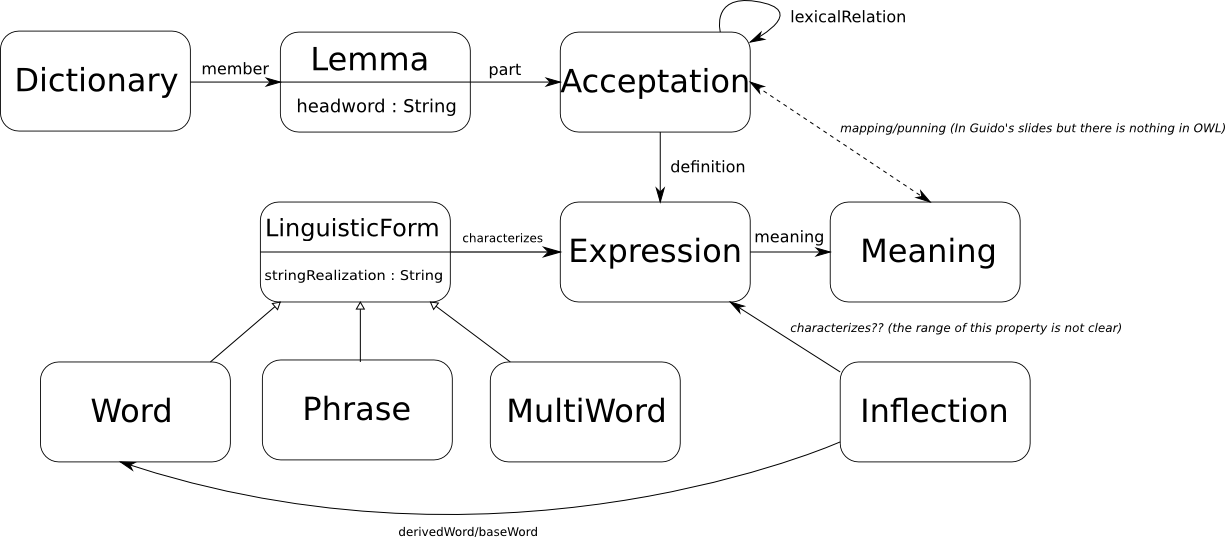- From: John McCrae <jmccrae@cit-ec.uni-bielefeld.de>
- Date: Thu, 14 Jun 2012 15:16:29 +0200
- To: Guido Vetere <gvetere@it.ibm.com>, Alessandro Oltramari <aoltrama@andrew.cmu.edu>, Philipp Cimiano <cimiano@cit-ec.uni-bielefeld.de>, Paul Buitelaar <paul.buitelaar@deri.org>, Aldo Gangemi <aldo.gangemi@istc.cnr.it>, public-ontolex <public-ontolex@w3.org>
- Message-ID: <CAC5njqq1gK_gAcp=L86p8BKjNjWXSoFLrwPpHP43nnnzbicU6g@mail.gmail.com>
Hi all, I had a look into the Senso Comune. First, I hit the issue that that the OWL files differ from Guido's presentation.... I think one of the important issues is that "MeaningRecord" from Guido's slides is entirely absent from the slides but there is a class called "Acceptation" that I guess is the same class. Next I could not find the "mapping/punning" relationship between MeaningRecord and Meaning... instead the link between Acceptation and Meaning is via the Expression class. I also found it quite odd that SC has no direct relationship between Lemmas and Words, however the Inflection class indicated that both "cat" and "cats" would be words (hence word=>form in lemon), which then confused me as this would lead to duplicate modelling of the canonical form of the word (e.g., "cat" would have both a Lemma with headWord="cat"@en and a Word with stringRealization="cat"@en) Based on these guesses (see attached diagram for SC core model as I understand it) I would suppose the following mapping exists: - sc:Dictionary = lemon:Lexicon - sc:Lemma = lemon:LexicalEntry: Represent that part of the dictionary describing this word - sc:Acceptation/MeaningRecord = lemon:LexicalSense: A meaning a single word or phrase - sc:Expression =~ lemon:SenseDefinition: A description of the meaning of a word - sc:Meaning =~ lemon's Reference: lemon takes a slightly different stance here in not mixing the ontology and lexicon (thus a referenced individual is not an instance of a lemon class) where as SC relies on categorization that are both the referenced ontology class and a sc:Meaning... I'm interested to here both viewpoints on the modelling here - sc:LinguisticForm = lemon:LexicalForm: Note here that in SC Word and Phrase subclass Forms where as in lemon Word and Phrase subclass LexicalEntry (sc:Lemma), perhaps someone from SC could comment on this? There are also some connection that differ - lemon connects entries to forms (sc: lemmas to words) by means of the form property that has no equivalent in SC - SC connects forms to definitions by means of characterizes... lemon has no such property - SC connects expressions to meanings (lemon: definitions to references) by means of the meaning property, lemon would consider this property to be between senses and references (sc: acceptation and meanings). But as Guido's slides suggest he opposite perhaps there is no difference here Furthermore, SC at times seems to go into much more detail hence why it is significantly larger (133 classes, 97 properties) than lemon (31 classes, 57 properties). With lemon we split off a lot of this modelling into another ontology called LexInfo (220 classes, 190 properties). As can be seen from attached screen shot this covers similar ground to SC. In summary, it seems that the models cover very similar ground and we should definitely attempt to learn from one another :) Regards, John McCrae OWL files referenced: http://www.sensocomune.org/ontologies/SensoComune.owl http://www.sensocomune.org/ontologies/SensoComuneLexicon.owl http://www.sensocomune.org/ontologies/SensoComuneSemantics.owl http://www.monnet-project.eu/lemon http://www.lexinfo.net/ontology/2.0/lexinfo
Attachments
- image/png attachment: Screenshot-10.png

- image/png attachment: senso-comune-core.png

Received on Thursday, 14 June 2012 13:17:05 UTC